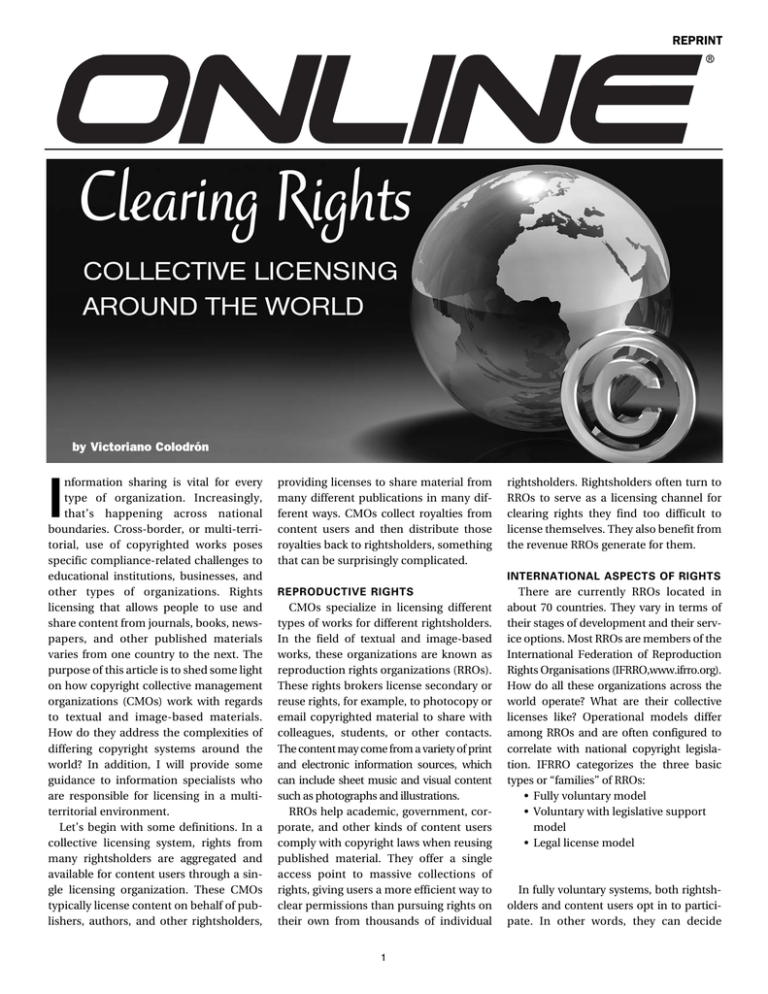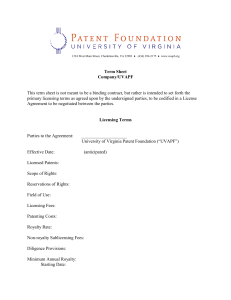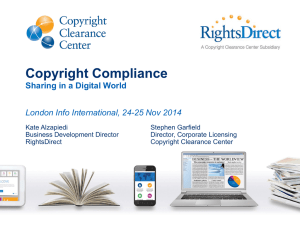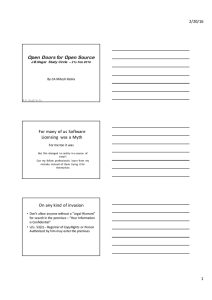
REPRINT
by Victoriano Colodrón
I
nformation sharing is vital for every
type of organization. Increasingly,
that’s happening across national
boundaries. Cross-border, or multi-territorial, use of copyrighted works poses
specific compliance-related challenges to
educational institutions, businesses, and
other types of organizations. Rights
licensing that allows people to use and
share content from journals, books, newspapers, and other published materials
varies from one country to the next. The
purpose of this article is to shed some light
on how copyright collective management
organizations (CMOs) work with regards
to textual and image-based materials.
How do they address the complexities of
differing copyright systems around the
world? In addition, I will provide some
guidance to information specialists who
are responsible for licensing in a multiterritorial environment.
Let’s begin with some definitions. In a
collective licensing system, rights from
many rightsholders are aggregated and
available for content users through a single licensing organization. These CMOs
typically license content on behalf of publishers, authors, and other rightsholders,
providing licenses to share material from
many different publications in many different ways. CMOs collect royalties from
content users and then distribute those
royalties back to rightsholders, something
that can be surprisingly complicated.
rightsholders. Rightsholders often turn to
RROs to serve as a licensing channel for
clearing rights they find too difficult to
license themselves. They also benefit from
the revenue RROs generate for them.
INTERNATIONAL ASPECTS OF RIGHTS
REPRODUCTIVE RIGHTS
CMOs specialize in licensing different
types of works for different rightsholders.
In the field of textual and image-based
works, these organizations are known as
reproduction rights organizations (RROs).
These rights brokers license secondary or
reuse rights, for example, to photocopy or
email copyrighted material to share with
colleagues, students, or other contacts.
The content may come from a variety of print
and electronic information sources, which
can include sheet music and visual content
such as photographs and illustrations.
RROs help academic, government, corporate, and other kinds of content users
comply with copyright laws when reusing
published material. They offer a single
access point to massive collections of
rights, giving users a more efficient way to
clear permissions than pursuing rights on
their own from thousands of individual
1
There are currently RROs located in
about 70 countries. They vary in terms of
their stages of development and their service options. Most RROs are members of the
International Federation of Reproduction
Rights Organisations (IFRRO,www.ifrro.org).
How do all these organizations across the
world operate? What are their collective
licenses like? Operational models differ
among RROs and are often configured to
correlate with national copyright legislation. IFRRO categorizes the three basic
types or “families” of RROs:
• Fully voluntary model
• Voluntary with legislative support
model
• Legal license model
In fully voluntary systems, both rightsholders and content users opt in to participate. In other words, they can decide
whether or not to work with the RRO.
Rightsholders do not have any legal obligation to mandate the RRO to license their
content on their behalf, and users are not
obliged by law to clear copyright permissions from that RRO.
Within this category, there are basically
two kinds of licenses: general repertory
licenses and transactional or “pay per use”
permissions. Repertory licenses give
licensees the rights to share content from
many publications in multiple ways. Payper-use permissions allow for a specific use
of a single work. Copyright Clearance
Center in the U.S. is an example of an RRO
with fully voluntary licensing solutions.
In some countries, RROs run partial
voluntary licensing operations with some
kind of specific legislative support. The
legal framework gives RROs the right to
issue licenses for the use of all content,
including foreign works, even without the
mandate of rightsholders. In these cases,
content users participate voluntarily, but
rightsholders do not. They may actually
have to opt out of the license. An example
of this system is the so-called Nordic model
of the extended collective license in
Norway (Kopinor), Denmark (Copydan
Writing), Sweden (Bonus Presskopia), and
Finland (Kopiosto).
Finally, legal licenses are those that are
given by law and usually cover specific types
of content use and users, such as educators.
In this type of agreement, rightsholder consent is not required to allow use of their
works within the legally established scope.
The works of all rightsholders, usually including foreign ones, are covered by the license.
Content users also have no choice. They
must pay without the chance to opt out. In
some cases, even the license fees are set by
law. For example, Australian RRO Copyright
Agency Ltd. operates a statutory system for
the educational and government sectors.
Other countries have a legally established remuneration for rightsholders for
the private copying of their works. The
remuneration comes from an “equipment
levy” imposed on certain devices and
media that allow for the reproduction of
works and/or from an “operator levy”
payable by institutions making large vol-
Bibliography
International Federation of Reproduction Rights Organisations (IFRRO). Collective Management Presentation,
at www.ifrro.org/content/education-0.
International Federation of Reproduction Rights Organisations (IFRRO). Collective Management in
Reprography, (www.ifrro.org/sites/default/files/wipo_ifrro_collective_management_1.pdf; also available in
Spanish, French, Russian, Chinese, Arabic and in an accessible version for the visually impaired from
www.ifrro.org/content/booklets).
Victoriano Colodrón. “Copyright Compliance in Private Companies: Challenges and Solutions” at WIPO
magazine, 3/2011, June 2011 (www.wipo.int/wipo_magazine/en/2011/03/article_0007.html).
Daniel Gervais, ed. Collective Management of Copyright and Related Rights. Kluwer Law International, 2010.
umes of copies. Systems of this kind are run
by VG WORT in Germany, Reprobel in
Belgium, OSDEL in Greece, and the RROs
of other European countries.
Some RROs offer a combination of features from the three aforementioned
licensing models. For example, CFC in
France operates a compulsory licensing
system through a legal mandate for photocopying in the business sector, but its
licensing model for digital content uses in
that sector is fully voluntary. In Spain,
CEDRO collects an equipment levy for private copying and runs a voluntary licensing
system for other types of content sharing.
PRACTICALITIES OF COMPLIANCE
The reality of vastly different licensing
models from one country to the next has
important practical implications for organizations with employees who need to share
text content throughout multiple countries
and across borders. For multinational or
multi-territorial companies trying to
ensure compliance with applicable copyright laws, here are a few important details
to consider.
Not all licenses are created equal. RROs
can vary significantly in terms of the content usage rights they offer, the markets
they serve, and the licensing models they
implement. For example, some RROs may
offer copyright permissions only for photocopying privileges and not for digital uses,
such as email. Some only provide licenses
for academic institutions, while others
license academic and business organizations. It all depends on local laws and the
level of rightsholder participation.
Companies looking for multinational
licensing should also check the breadth and
depth of a license’s repertory. This can get
complicated. Does the license offer consistent content usage rights for all the materials
covered? This may not always be the case.
Businesses should also check the geographic scope of a license. This is crucial for
organizations that need to use content in
several countries and from country to
country. Some RROs license content for use
within national boundaries. Other licenses
allow content sharing across organizations
around the world. For example, the
Multinational Copyright License offered by
Copyright Clearance Center (www.copy
right.com) and its subsidiary RightsDirect
(www.rightsdirect.com) gives organizations the rights to share content from a
range of information sources through photocopy, email, and intranets, in the country
where the license is purchased, as well as
across borders.
The significant differences between collective licensing models around the world
are only one aspect of the complexities of
global copyright. RROs deliver services that
result in increased efficiencies for content
users. To make the most of them, it
is important for information specialists
dealing with rights clearance to know the
different models in place and assess the
relevance of the licenses that RROs offer.
Victoriano Colodrón (vcolodron@rightsdirect.com)
is executive director of RightsDirect/Copyright
Clearance Center.
Comments? Email the editor (marydee@xmission.com).
This article is reprinted in its entirety from the Nov./Dec. 2011 issue of ONLINE magazine, published by Information Today, Inc. Used with permission. All rights reserved. Individuals
may download, store, and print a single copy. All commercial uses, including making printed copies for distribution in bulk at trade shows or in marketing campaigns and all commercial reprints require additional permission from the publisher. www.infotoday.com
2




